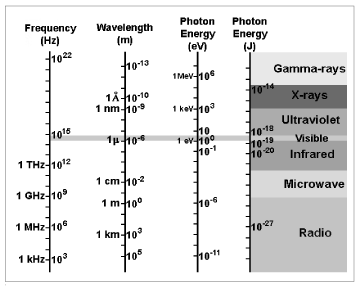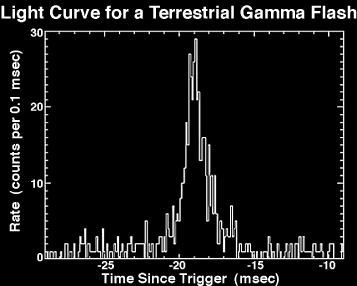Gamma-Ray Bursts - Answers
V. Answers
1. Apparently, They are Absolutely Bright
1. The data are in the form of a power law.
2. Given an equation of the form y=axb, if a becomes larger, the distance between the curve and the x/y axes becomes larger. If a remains positive, but becomes smaller, the curve moves closer to the axes. If the absolute value of b becomes larger, the rate of change of the line is greater. If the absolute value of b becomes smaller, the rate of change of the line is smaller.
3. Knowing how bright something is does not really tell you anything quantitative about the energy emitted by the object. It may be bright because it is nearby, or it may truly bright. It may be dim because it is far away, or it may be truly dim. An astronomer needs to know something about the distance to the object in order to draw any conclusions.
2. It’s Either Probable, or It’s Not
1. No, the distribution of GRB locations in the sky is random.
4. 1/5
8. As you perform more and more trials, the theoretical and average experiment values will come closer together. Once you get over a thousand or so trials, the values will have essentially become equal and performing additional trials does not gain you much.
10. Given the random distribution in the sky, looking at a smaller part of the sky for a longer time will provide the same results as looking at the whole sky for a shorter time.
11. A instrument to observe a smaller field-of-view may itself be smaller. Thus it could be easier to construct, weight less so as to be easier to launch, cheaper to construct, and so on. A larger detector can see more at once, but it is more difficult and costly to make and launch such a device. However, the space environment is a harsh one in which an instrument must operate. So having an instrument provide as much data as possible in as short a time as possible is something to consider.
3. Blast from the Past
You may need to learn about units astronomers use to do this exercise. Here is a start, a parsec (pc) is equal to a distance of 3.26 light-years. Light travels at about 300,000 km/second.
Burst
970508
971214
980703
990123
The two values given for distance are done based on the minimum and maximum Hubble constant values.
Taking the mid-range value of 3.3x106 Mpc, or roughly 10 billion light-years, the light has been traveling for about 10 billion years. This tells us that the Universe is at least 10 billion years old. Based on the idea that GRBs originate with black holes, this tells us that 10 billion years ago, some type of stellar evolution must have already had time to take place. This could add a few billion years to the overall age of the Universe.
4. A Sensitive Situation
1. about 1 GRB/year
2. 100.6 = 0.4 photons/cm2/second
3. ~ 102.5 = 316/year or ~ 6/week
5. When You’re Hot, You’re Hot…Unless You’re Not!
Using Wein’s Law, we find a temperature of 2.897x109 Kelvin. Be careful about your units!
The core of the Sun is about 15,600,000 Kelvin. So, if the gamma-ray emission of a GRB is thermal in nature, the material would have to be over 100 times hotter than the core of the Sun.
It’s hard to think of such a thing and, in fact, we are led to think that GRBs are not thermal in nature. Something else, some other physical phenomena, must be responsible for the gamma-ray emission of a GRB.

Below is a good reference chart for converting between frequency, wavelength, and energy (in two different units) for the various regions of the electromagnetic spectrum.

7. The Power of These
1. The light bulb would be 10,000,000 ergs/sec and the gamma-ray burst would be 100,000,000,000,000,000,000,000,000,000,000,000,000,000,000,000,000,000 ergs/sec.
2. You would need 1046 light bulbs. You would need 1020 Suns!
3. The distance between the campfire and the nuclear power plant is 5 meters; this represents a difference in power of a factor of 105 ergs/sec. The distance between the H bomb and the Sun is 13 meters; this represents a difference in power of a factor of 1013 ergs/sec. The distance between the nuclear power plant and a GRB is 38 meters; this represents a difference in peak power of a factor of 1038 erg/sec.
8. True or False
a. True. A single GRB at 1% efficiency could serve Earth’s power needs for a hundred thousand billion billion (1023)years. GRBs can emit about 1054 ergs of energy. Worldwide energy use is approximately 1029 ergs/year.
b. False. Most GRB’s, including 990123, GRBs originate very, very far away. The flux from them which reaches Earth is easily absorbed by the Earth’s protective atmosphere. Only a GRB which occurs close by could pose a problem. Such GRB blasts are thought to occur rarely in our own Galaxy, perhaps once every million years. Researchers have estimated that an intense burst within 3,000 light-years of Earth could produce radiation at sea level equal to about 100 times the fatal dose for humans.
c. True. The graph below shows the time history of one of the events known as Terrestrial Gamma Flashes (TGFs). These events were discovered with BATSE to originate from high in the Earth’s atmosphere, and are believed to be associated with large thunderstorm activity.

(Fishman, G. J. et al., 1994, Science, 264, 1313).
9. About Once a Day
Using a quick method (just looking at the number of bursts per day and ignoring the time of day the burst occurred), you would get the following results:
Mean: 0.86 days
Median: 1 day
Mode: 1
If you do an exact calculation, converting the days and seconds of days into total seconds (remember a day has 86,400 seconds), you obtain the following:
Mean: 99795.501 seconds (1.15 days)
Median: 67765.539 seconds (0.784 days)
Mode: none
These measures tell us that there is a significant variation around the "once a day" value.
Maximum Time Interval: between GRB#s 5581 and 5585 is 363,928.577 seconds (~ 4.2 days)
Minimum Time Interval: between GRB#s 5562 and 5563 is 14174.969 seconds (0.164 days)
What you begin to understand is that you need to look all the time — because you just never really know when the next burst will occur!




